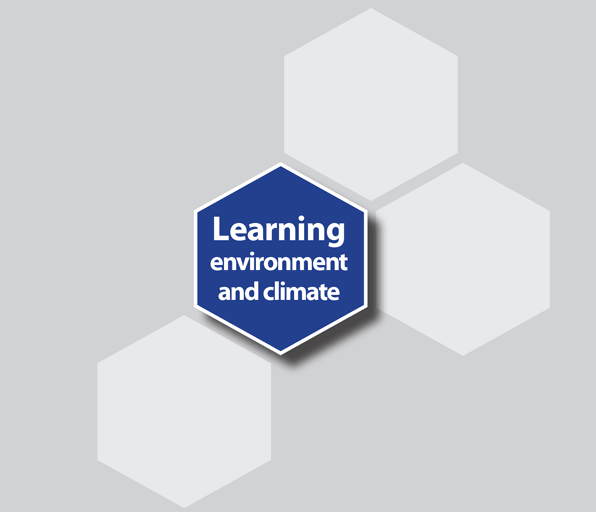Introduction
Even with the most extensive content knowledge, the most engaging PowerPoint slides, and the best of intentions, there is no guarantee optimum learning will occur when you teach. If the environment is not positive and does not support student growth and learning, teaching may be an opportunity lost or, worse, a negative experience which may have serious detrimental effects down the line.
Understanding the central purpose of teaching (CPT), the main and singular goal of teaching, along with the implications, will allow us to be more intentional about our teaching, to identify and distinguish between more effective and less effective teaching, and to improve by keeping the end in mind.
Learning Objectives (what you can reasonably expect to learn in the next 15 minutes):
- Name two positive outcomes and two negative outcomes of learning climates.
- Differentiate between learning environment and climate.
- Describe three broad areas that contribute to the learning environment.
To what extent are you now able to meet the above objectives? Please record your self-assessments. (0 is not at all and 5 is completely)
To what extent are you now able to meet the above objectives? Please record your self-assessments:
Learning Environment and Climate
There is need to do what we can to create a positive learning environment to maximize the likelihood of and potential for learning. While learners certainly share in the responsibility of learning, something we cannot do for them, attending to some of the factors that influence the learning environment will increase the effectiveness of teaching sessions, courses and the entire program. We need to give just as much attention and energy addressing the broad context of our teaching encounters (the learning environment and the systems within which learning and teaching take place) as we do addressing the content or the material we are teaching.
What is a learning environment and why is it important?
Just as balsam poplar and white birch trees may flourish in certain environments (wet, light soil, for example), learners thrive in positive learning environments. With trees and for people, while there are certainly some unique features to an optimal environment for specific individuals, there are also some universal principles as well.
A positive learning environment creates a situation where a learner wants to learn and feels optimistic about their chances of success. If a learner feels unappreciated, disrespected, uncertain, or fearful, then chances of successful learning decrease. Dunham et al (2017)1 note that the learning environment can contribute to positive outcomes such as student well-being, empathy, professionalism, and academic success. On the other hand, a poor learning environment can contribute to negative outcomes of burnout, exhaustion, and lack of empathy.
Some authors differentiate between learning “environment” and “climate” while others use the terms interchangeably. What is important is identifying the difference between factual aspects of the environment and student perceived experiences. The environment includes all the physical, academic, and social factors that provides the context and infrastructure for learning. This certainly means the entire curriculum (including but more than the individual course or learning sessions) but goes beyond the curriculum as well. The environment of the medical school also refers to the perception of the environment or the effect the environment has internally on students. For example, a medical school may design its curriculum to teach content with a “block” approach, teaching one system at a time – a fact. The intention may be to help students focus, with a goal of better retaining the content. However, students may perceive this format as monotonous and removed from clinical reality. This appears to be the hidden curriculum at work.
“Curriculum’s most significant manifestation and conceptualization is the environment, educational and organizational, which embraces everything that is happening in the medical school. There is a proven connection between the environment and the valuable outcomes of students’ achievement, satisfaction and success.2
Before we explain the various dimensions of the medical school learning environment, from your own understanding at this moment, please attempt to name and/or describe some of those factors or components.
The DREEM inventory covers the following components of the learning environment (with example questions). The complete list of questions is included in Pai et al (2016)3.
Learning: “I am encouraged to participate in class.” and “The teaching over-emphasizes factual learning.”
Teachers: “The teachers are patient with patients.” and “The teachers provide constructive criticism here.”
Academic: “Much of what I have to learn seems relevant to a career in healthcare.” and “Problem solving skills are being well developed here.”
Atmosphere: "“Cheating is a problem in this school.” and “The enjoyment outweighs the stress of the course.”
Social: “There is a good support system for students who get stressed”. and “I am too tired to enjoy the course.”

Under which heading of the DREEM inventory would the above cartoon illustration fall?

Under which component of the DREEM inventory would this second cartoon illustration fall?
Check for Understanding
Self-assessment
To what extent are you NOW able to meet the following objectives? (0 is not at all and 5 is completely)
Objectives
To what extent WERE you able the day before beginning this CORAL Cell to meet the following objectives? (0 is not at all and 5 is completely)

Thank you for completing this CORAL Cell. We are interested in improving this and other cells and would like to use your answers (anonymously of course) along with the following descriptive questions as part of our evaluation data.
Thanks again, and come back soon!
The CORAL Cell Team
References:
1 Dunham L, Dekhtyar M, Gruener G, CichoskiKelly E, Deitz J, Elliott D, Stuber ML, Skochelak SE. Medical Student Perceptions of the Learning Environment in Medical School Change as Students Transition to Clinical Training in Undergraduate Medical School. Teaching and Learning in Medicine. 2017 Mar 16:1-9.
2 Genn JM. AMEE Medical Education Guide No. 23 (Part 1): Curriculum, environment, climate, quality and change in medical education–a unifying perspective. Medical teacher. 2001 Jan 1;23(4):337-44.
3 Pai PG, Menezes V, Srikanth AM, Shenoy JP. Medical students’ perception of their educational environment. Journal of clinical and diagnostic research: JCDR. 2014 Jan;8(1):103.
4 Hsiang-Te Tsuei S, Lee D, Ho C, Regehr G, Nimmon L. Exploring the Construct of Psychological Safety in Medical Education. Academic Medicine. 2019 Aug 27.
Additional Resources:
Canadian Safety Association. 2019. Psychological health and safety for post-secondary students (Draft New Standard). https://publicreview.csa.ca/Home/Details/3592
Jamaiah I. Review of research in learning environment. JUMMEC: Journal of Health and Translational Medicine. 2008 Jun 30;11(1):7-11.
Skochelak SE, Stansfield RB, Dunham L, Dekhtyar M, Gruppen LD, Christianson C, Filstead W, Quirk M. "Medical student perceptions of the learning environment at the end of the first year: A 28-medical school collaborative." Academic Medicine 2016 Sep 1;91(9):1257-62.
Lydon, S., Byrne, D., Vellinga, A., Walsh, C., Madden, C., Connolly, F., & O'Connor, P. (2019). A Mixed-Methods Exploration of the Educational Climate and Safety Climate During the First Year of Clinical Practice in Ireland. Academic Medicine. 2019 Aug 6.
Credits:
Author: Sean Polreis, Marcel D’Eon, University of Saskatchewan
Series Editor: Marcel D’Eon
Reviewer/consultant:
